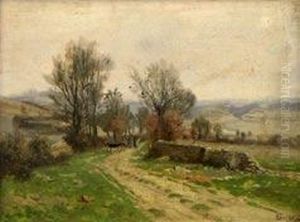Claudius Seignol Paintings
Claudius Seignol was a French painter born in the late 19th century, specifically in 1870, and his work spanned several decades until his death in 1942. Seignol's art career was marked by a dedication to exploring the nuances of light and shadow, a pursuit that aligned him with the Impressionist movement, despite the fact that he often ventured beyond its typical boundaries in both subject matter and technique.
Seignol was born in Lyon, France, a city known for its vibrant arts scene and historical importance in the development of French art. From a young age, he demonstrated a keen interest in painting, and this passion led him to pursue formal training. He studied at the École des Beaux-Arts in Lyon, where he was influenced by both his instructors and the rich artistic tradition of the region. His early works were characterized by a focus on landscapes and urban scenes, capturing the changing effects of light with a sensitivity that became a hallmark of his style.
Throughout his career, Seignol exhibited his work frequently, participating in salons and group shows across France. His paintings were well received, and he garnered a reputation for his ability to imbue ordinary scenes with a sense of emotion and atmosphere. Despite this, Seignol never achieved the level of fame enjoyed by some of his contemporaries. His work, however, has been appreciated for its contribution to the post-Impressionist movement, as he continued to explore and innovate within the realm of landscape painting.
Seignol's later years were marked by a continued dedication to his art, though his output slowed as he aged. He remained in France, drawing inspiration from its countryside and cities alike until his death in 1942, amid the turmoil of World War II. Today, Claudius Seignol's paintings are held in several French museums and private collections, where they are celebrated for their technical skill and the evocative beauty of their subjects. His legacy is that of a devoted artist who sought to capture the fleeting moments of light and life, contributing quietly but significantly to the fabric of French art.








